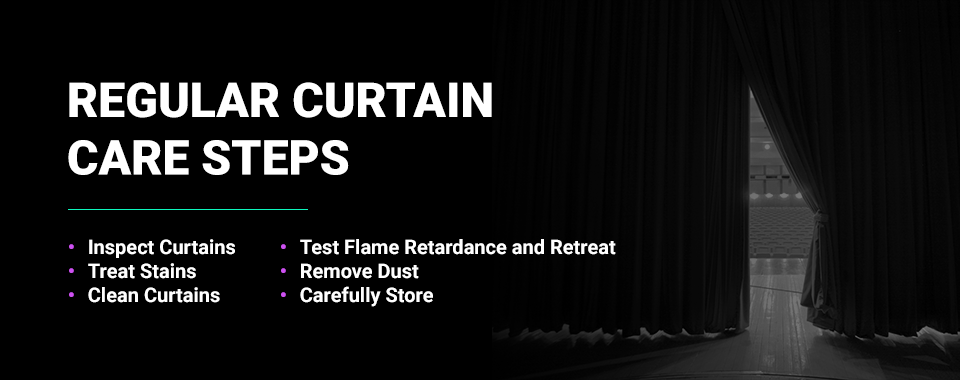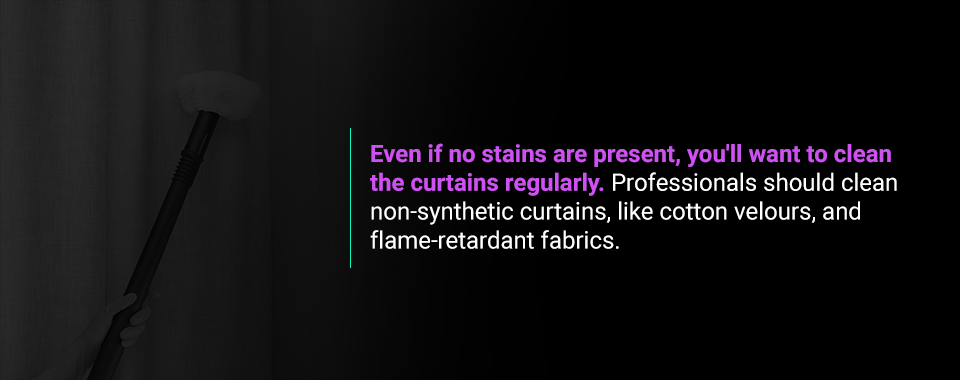

Your stage may be home to a variety of awe-inspiring shows, but your curtains provide a frame for the entire experience and say a lot about your stage. Rips, stains, marks and a loss of fire-retardant properties are all ways that curtains can lose their quality over time. Thankfully, taking care of your stage curtains isn’t too complicated, and it can keep them looking good for years to come.
Keep reading for more information on the total care process for stage curtains, fabric care, cleaning methods and storage options.
A significant factor in taking care of your drapery involves the material they are made of. Some common curtain materials include:
Some materials are harder to clean than others and may require specific steps, so you’ll need to know how the fabric of your curtain behaves.

Different curtain types have different methods of cleaning. If you don’t follow correct cleaning procedures, you could stain your curtains, end up with severely wrinkled material or even ruin the fabric beyond repair. Below are some of the types of cleaning you will need to perform regularly with your curtains at different timeframes.
One way to keep your curtains in good shape is to implement a regular curtain cleaning schedule. You should perform some tasks as often as needed, while others can usually be done monthly or yearly. If you buy curtains with Illuminated Integration, we can help you identify appropriate maintenance tasks and how often you’ll need to perform them.
Most of the following tasks tend to be obvious when they appear and need to be addressed as they come up.
You should do some checks monthly to make sure your setup is in working order.
Annual tasks are more focused on cleaning and ensuring the continued upkeep of the appearance of your curtains.

Whether you have stage curtains, acoustical curtains or curtain room dividers, you can keep all types in good condition with a few regular tasks.
The first step to curtain care is to inspect them visually. Look for any tears, rips or other physical damage, all of which can lead to more substantial issues later on. Repair any problems straight away. This visual inspection applies to all components of the curtain track and hardware, such as S-hooks and grommets. Make sure they are in good condition, with proper structure and shape, free of rust or corrosion and the cords are moving freely but without slack. Check that the curtain does not touch the floor.
If the curtain is physically in good condition, look for stains and marks as well. Grease stains from a stray cherry-picker, paint from set-pieces and a wide variety of other harsh substances can land on your curtains and require removal. If you find a stain right away, try to prevent it from setting. Once it sets, it is much more difficult to remove. Don’t press the stain in or add heat to it. Immediately remove as much of the substance as possible, and find the appropriate technique for the material you’re working with.
Remember that many stains become worse if you treat them as you would another substance. If you find any stains, be sure to follow appropriate cleaning procedures for your materials. Some common ones you may find in a theater environment include:
Paint
For latex-based paint, use mild laundry detergent and warm water if it’s still wet. Then rinse the spot with clean water. Oil-based paint should come out with the solvent listed on the can or turpentine. Dried paint may come out with a water-soluble paint remover, but this is difficult.
Once a stain has set, removal may be more difficult. Enlisting the help of a professional dry-cleaner may be the most effective route. Otherwise, pretreat the stain, so it comes off more easily during cleaning. Take steps to remove as much of it as you can.

Even if no stains are present, you’ll want to clean the curtains regularly. Professionals should clean non-synthetic curtains, like cotton velours, and flame-retardant fabrics. Don’t forget that they should use the right cleaning solutions to keep the flame retardant treatment in place. If this is not possible, you’ll need to retreat them for flame retardance. For synthetic fabrics, you can clean smaller sections at home, but most people won’t have the capacity for more substantial parts. You can wash them in the delicate cycle, with cold water and a gentle detergent. Do not completely fill the washer or use any bleach. To dry the curtains, hang them or tumble dry them on low heat. Hang the drapes immediately after cleaning to avoid wrinkling.
Commercial drapes need to be resistant to flames for added safety in public places. Many stages are build from fast-burning wood, and cotton or plastic-based fabrics add to the risks surrounding a stage. At Illuminated Integration, we can help you find the right options for flame retardance on your curtains.
Be sure to test your curtains’ flame retardance regularly and check with local codes as to how often you should renew your certificates. Many treatments are water-soluble, so humidity can affect how long your flame retardant treatment lasts. Fire safety is another reason to keep dust off of curtains, as dust creates a layer of combustible material.
To ensure you keep your certification up-to-date, you can retreat the curtains in a few ways.
For some cleaning efforts, thorough dust removal is enough to keep curtains looking nice. Shake them out or beat them like a rug to get some of the dust out. After that, use a soft-bristled brush to remove more dust. A clean broom will work for large areas. You can do this with a ladder or lift while the curtains are hanging or lay them down. If laying them down, clean the stage or place a layer like plastic or paper between the stage and the curtains.
Once you’ve restored your curtains to tip-top shape, make sure you store them correctly to keep wrinkles and mold at bay. Ideally, you should leave them hanging, but if you must take them down, fold your curtains along the width until they are a few feet wide and roll them up. Don’t store them in plastic bags, but in a special drapery or canvas bag or a canvas hamper that can breathe. The area it is stored in should be well-ventilated.
When it’s time to use them again, try to let them hang for a day or two so the wrinkles go away. Misting the curtains with warm water can help this process, as well.

As you can see, looking after theatrical curtains doesn’t need to be a complicated task, but it may also require some specialized care. Removing stains, dust and damage can help your curtains look good and remain structurally sound, while testing and retreating them as needed helps you to stay compliant and improve the safety of your stage.
Whether it’s time for entirely new curtains or you’d like to revitalize your existing setup, Illuminated Integration can answer the call. We can help to modernize your stage with our creative curtain design and advise on proper maintenance procedures for the years to come. Read up on our work with curtains to learn what a partnership with Illuminated Integration means for your stage.